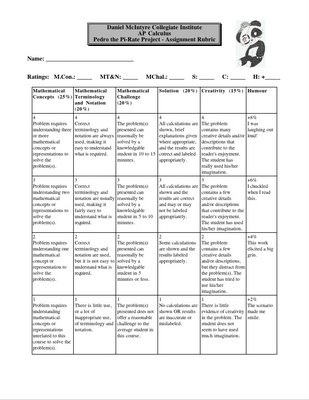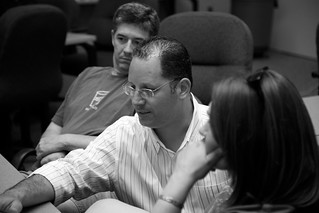What Does Success Look Like?
11/20/2006 10:30:00 pmOn the one hand ...
My grade 12 Pre-Cal 40S class handed in their first project today. Tomorrow my grade 11 Pre-Cal 30S will get their first project assignment. My AP Calculus class has begun work on their digital story; this year's project is called Pedro the Pi-Rate Panda (nothing there yet; the first problem will be published next week).
On the other hand ...
My son (grade 5) spent the better part of the last month working hard on a project about porcupines. He uncovered lots of interesting facts and taught my wife and I a few things as well. He even shared some of his learning with the folks at Ed Tech Brainstorm on October 19 (both my kids come in at the 25 min 45 sec mark -- yeah; I'm a proud papa ;-)). He received the graded assignment back last week. His mark was not what he was hoping for. We were surprised by the assessment criteria. The original sheet of instructions did not detail some of the characteristics that were part of the final assessment scheme. We also thought it would have been helpful for our son to know the weighting of the different factors that were being assessed.
So ...
In the course of my recent research and learning about assessment, the idea of making success criteria transparent is emphasized again and again. I want my students to succeed. As a class our goal is for everyone to achieve between 80% and 100%. I have structured my assessments (above) so that students can achieve, with a reasonable amount of effort, marks in the high 80s.
This is the rubric I use for projects in all my classes. It is an adaptation of a rubric I found at the SMARD site (Secondary Mathematics Assessment and Resource Database -- founded by Rex Boggs, the site has gone under ... another blow to the international secondary mathematics community. Thankfully Rex's Exploring Data site is still up; I hope it stays up for a long, long time.)
I spent a lot of time discussing with the students what excellence looks like. I showed examples of past students work. 50% of their grade is for the math content. I told them up front, "If you come talk to me about it I will walk you through it until you understand and get it perfect. That means you'll be guaranteed a perfect score for the mathematics which automatically means a grade of 50%. If you write a careful description of how you solved the problem and what all the numbers mean, coupled with a neat presentation including a cover page in a duo-tang folder your Communication and Presentation marks will fall at least in the second highest category -- you'll get 88%."
We also talked about how a flashy presentation isn't what I'm looking for unless it adds to the clarity of the mathematics. Students have turned in "webs sites" and failed this assignment. Flash and glitter don't earn the high marks; high quality content does.
This is the rubric I'm using with the AP Calculus kids for their digital story:
I found myself questioning the validity of grading the student's "Creativity." How do you mark creativity? Sir Ken Robinson's presentation from Ted Talks was a strong motivator for including and encouraging student creativity in my student's work. I have spent more time developing this rubric (above) than any other. I used RubiStar to help get ideas for building the rubric. I mixed and matched rubric classifications from mathematics, writing, art and more. Then I reworked those basic ideas into what appears above.
In class we talked about rewriting some of the descriptors and redistributing the weighting of the various categories. I was particularly concerned that they would have a good grasp of what excellence would look like and what they had to do to achieve it.
After a very close look at all aspects of the rubric the final decision by the class was to keep the rubric the way it was. I asked the students over and over again: "Does this give you a clear enough guideline to do well? Do you know what you have to do to achieve excellence?" They said yes ... one student has made a graphic image of Pedro (click on the rubric above, then click on it again to zoom in). The same student has composed some theme music for Pedro that will be added to the project blog by tomorrow ... now we'll see what they do with it ...





2 comments
Darren who is marking this assignment. As a middle school teacher I would make the students mark their own work first. Then have a partner mark their work and then the teacher gets the last chance to mark. Often kids do not go through their work with a fine tooth comb. By giving them the opportunity to check their own work you can further teach the content and improve the quality of the product. Peer edits are also great when their fellow students point out what they thought was good or needing improvement. I wish I had you as a high school math teacher. Thanks for caring and always pushing yourself to new and higher goals.
ReplyDeleteChris Harbeck
Sargent Park School
I've been immersed in this stuff for about 3 years. Our province is really into Assessment For Learning...the whole Rick Stiggins stuff.
ReplyDeleteThis post would be of an exemplary nature when showing teachers how to set up proper assessments and incorporating students as part of the process. Fine work.
Skype me sometime...we should talk.